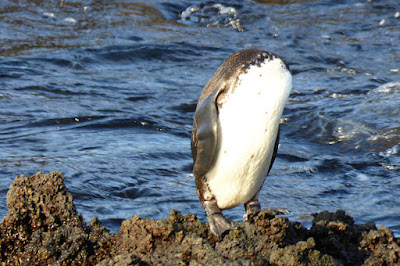Our expedition spent the morning of May 13th zodiac cruising, kayaking, and snorkeling. The Islander was parked between Sombrero Chino and the Bainbridge Islets, all small volcanoes probably formed as parasitic cones of the much larger Santiago Island, the fourth largest island in the Galapagos.
The Islander first unleashed a wave of zodiacs and kayaks, both for the enjoyment of the guests and to gauge the water's suitability for snorkeling.
Sombrero Chino translates to "Chinese Hat," and you can see why in the above photo.
We poked around the nearby islets.
One spot suddenly attracted attention.
Everyone's attention!
Was it the striated heron on the water's edge that beckoned to us?
Or maybe the pelican?
No, it was a "we might see one on this trip" Galapagos penguin!
Yes, a penguin at the equator; the water is cold with upwelling from deeper ocean currents, and provides lots of nutrients to support the food chain.
Our penguin was engaged in some grooming.
The conditions were deemed suitable for snorkeling, and after breakfast the swimming began. Those who preferred not to snorkel could take further zodiac cruises, or visit a pretty white beach suitable for swimming or gazing. (As it turned out, the white beach had eroded badly since the last visit, and was only a few yards wide.)
Joan and I snorkeled, and I decided to venture without a flotation vest. My snorkel, a few millimeters too narrow to properly fit my mask, liked to fall out if I released it from my mouth to talk, and without the vest, I had to work harder to keep above water while fussing with the snorkel. After the swim I mentioned this to Lynn, the expedition leader, and she gave me a new snorkel. (All the gear, wetsuit, mask, fins, and snorkel, were from the ship's stock.)
We saw species traveling in swarms, such as these rainbow wrasse. This photo reveals how rapidly the color changes as the water deepens.
A brigade of sergeant majors.
The combination of light and life forms both mobile and affixed to rocks was dazzling.
Our friend Rick was like another fish.
There were sea stars on the sandy bottom, but they were too deep for a good picture.
Something was really, really interesting to these yellow-tail surgeonfish.
It was good to also pay attention to the shore. Here we have both a great blue heron and a Galapagos penguin, likely the same one we'd seen from the zodiacs (click on the image to enlarge).
There's a lot going on ahead of me.
I began to struggle to keep up as the swim went on. The toe that had chafed some yesterday was rubbed by every fin stroke, and my leg muscles wanted to cramp. The water was colder than before as well.
An enterprising snorkeler had placed a camera on the bottom to capture some action.
Here's a concentric puffer fish, a new species for me on this trip.
I love the next picture. It's a parrot fish flashing all her glorious colors as she nibbles on the algae growing on the rocks and corals. Many species of parrot fish change color and gender (from male to female) as they age. This brilliant turquoise and pink specimen is a female. Get a few of these feeding together and it sounds like popcorn popping as bits of rock/coral snap off.
My final photo of this swim is a also a parrot fish, with a predominantly orange color, presumably younger than the one above.
The timestamps on my photos tell me I was in the water for at least and hour and ten minutes, and I was definitely ready for it to be over, as was Joan. Next time I'll wear cycling socks to protect my chafed toes.
Then the Islander was on the move again, followed by lunch. Time to start the next post ...






















No comments:
Post a Comment
Comments may not appear immediately as they are moderated by the author to eliminate spam.